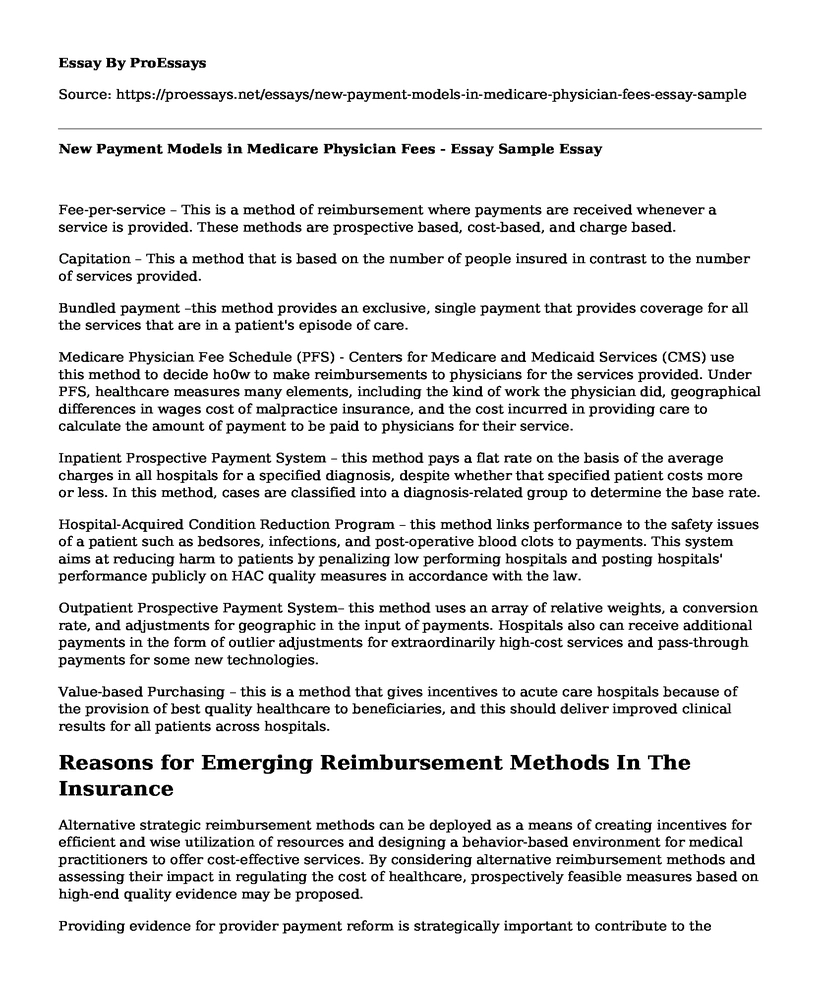Fee-per-service – This is a method of reimbursement where payments are received whenever a service is provided. These methods are prospective based, cost-based, and charge based.
Capitation – This a method that is based on the number of people insured in contrast to the number of services provided.
Bundled payment –this method provides an exclusive, single payment that provides coverage for all the services that are in a patient's episode of care.
Medicare Physician Fee Schedule (PFS) - Centers for Medicare and Medicaid Services (CMS) use this method to decide ho0w to make reimbursements to physicians for the services provided. Under PFS, healthcare measures many elements, including the kind of work the physician did, geographical differences in wages cost of malpractice insurance, and the cost incurred in providing care to calculate the amount of payment to be paid to physicians for their service.
Inpatient Prospective Payment System – this method pays a flat rate on the basis of the average charges in all hospitals for a specified diagnosis, despite whether that specified patient costs more or less. In this method, cases are classified into a diagnosis-related group to determine the base rate.
Hospital-Acquired Condition Reduction Program – this method links performance to the safety issues of a patient such as bedsores, infections, and post-operative blood clots to payments. This system aims at reducing harm to patients by penalizing low performing hospitals and posting hospitals' performance publicly on HAC quality measures in accordance with the law.
Outpatient Prospective Payment System– this method uses an array of relative weights, a conversion rate, and adjustments for geographic in the input of payments. Hospitals also can receive additional payments in the form of outlier adjustments for extraordinarily high-cost services and pass-through payments for some new technologies.
Value-based Purchasing – this is a method that gives incentives to acute care hospitals because of the provision of best quality healthcare to beneficiaries, and this should deliver improved clinical results for all patients across hospitals.
Reasons for Emerging Reimbursement Methods In The Insurance
Alternative strategic reimbursement methods can be deployed as a means of creating incentives for efficient and wise utilization of resources and designing a behavior-based environment for medical practitioners to offer cost-effective services. By considering alternative reimbursement methods and assessing their impact in regulating the cost of healthcare, prospectively feasible measures based on high-end quality evidence may be proposed.
Providing evidence for provider payment reform is strategically important to contribute to the decision-making process to tackle the increasing costs of health services for LMICs. This will contribute to the ongoing reforms toward universal healthcare coverage.
Alternative payment methods have emerged because the existing Fee-for-service leads to excess use of services by encouraging supplier-induced phenomenon because the beneficiaries depending on the provider's information on their needs for medical attention. This method even escalates under instances of third-party payers such as services financed by insurance. This is as a result of both patients and providers not bearing the financial risk of the cost of service provided. This practice can lead to a situation where some patients who believe that expensive treatments mean quality care to become somehow satisfied. Also, insured patients may overuse this service. This moral hazard is another phenomenon associated with increasing demand for free or subsidized service. Such phenomena may continue to increase with the existing FFS reimbursement policy (Alshreef, 2019).
The fee-for-service method leads to over usage of pharmaceuticals. The pharmaceutical industry keeps on pressuring doctors to prescribe new/generic medicines, which are unjustifiably costly. Under the FFS method, where there are no regulations for reimbursing prescriptions, it becomes challenging for health insurance schemes to control the cost of pharmaceuticals hence creating a need for a more regulated method.
Compared to other methods of payment, administrative costs for fee-for-service is relatively high. This is because the insurer is required to process the auditing of detailed provider claims retrospectively based on smaller units.
Impact of Emerging Reimbursement on Cost, Quality, and Access to Patient Care
Emerging payment methods have the following impacts on health care:
When payments are contracted for long-term periods with bonuses as incentives, providers focus on improving the quality of health of demographics by more cost-effective healthcare like prevention and promotion interventions.
Inpatient Prospective Payment Systems provides a cushion for high costs associated with patients with chronic illnesses within each diagnosis. In cases of moral hazard, the patients' losses are covered by the insurer emerging methods also have strong incentives, which create the need for efficient use of resources when providers bear more financial risks for the services they offer.
Conclusion
Over the years, medical care cost has kept surpassing inflation with no signs of slowing down. This brings the question of whether the traditional approaches are really improving the quality of medical care, thus bringing the need to review reimbursement methodologies to establish a balance between the fee and services rendered.
References
Alshreef, A. (2019). Provider payment mechanisms: effective policy tools for achieving universal and sustainable healthcare coverage.
Zuvekas, S. H., & Cohen, J. W. (2016). Fee-for-service, while much maligned, remains the dominant payment method for physician visits. Health Affairs, 35(3), 411-414.
Cite this page
New Payment Models in Medicare Physician Fees - Essay Sample. (2023, Aug 13). Retrieved from https://proessays.net/essays/new-payment-models-in-medicare-physician-fees-essay-sample
If you are the original author of this essay and no longer wish to have it published on the ProEssays website, please click below to request its removal:
- Implications of the ANA's Position on Ethics - Essay Sample
- The Government Audit Standards Essay Example
- Pediatrics: Common HEENT Disorders & Symptoms for Diagnosis - Essay Sample
- Essay Sample on Juul: Leading US E-Cigarette Company Since 2015
- Paper Example on U.S. vs. Canada: Comparing Health Care Cost and Quality
- Stocks Market Behavior in the UK - Report Example
- Essay Example - Sexually Transmitted Diseases in Older Adults







